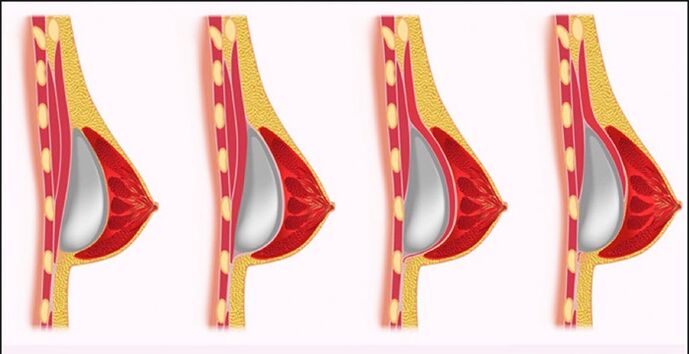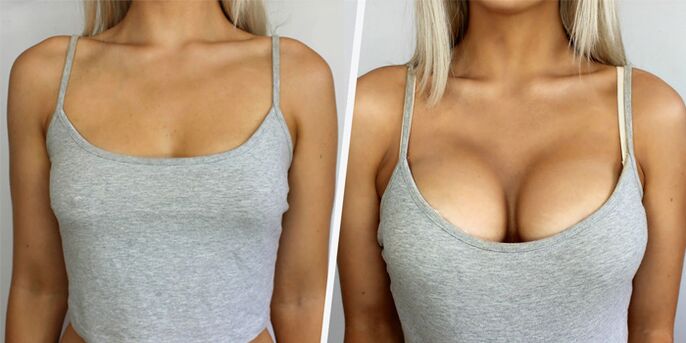Correction of shape, breast augmentation is one of the most popular plastic surgery procedures. With the help of mammoplasty, you can correct congenital or acquired breast malformations, restore its volume, elasticity after childbirth and breastfeeding. Correctly performed surgery helps a woman become more attractive and more confident.
Surgical indications
- Descent and decrease in the elasticity of the mammary glands (mastoptosis).
- Increase in breast volume while maintaining its tone and position (macropathy).
- Reduction of mammary glands after lactation.
- Small breast size (micromastia).
- Increase in breast volume in men (gynecomastia).
Types of mammoplasty
- Augmentation mammoplasty(endoprostheses) - breast augmentation, correction of its shape with the help of implants. It is used after childbirth, breastfeeding, with congenital asymmetry.
- Reduction mammoplasty- Reduction in the size of the bust with mastoptosis or macropathy.
- mastopexy- breast lift. It is indicated for mastoptosis, if the breast size meets the requirements of the operation.
Mammary gland stents
The operation involves placing silicone prostheses (implants) in the mammary glands. The choice of the incision site is consistent with the woman. The implant is placed under the pectoral muscle, and if the breast size allows it, between the muscle and the mammary gland. The incision is sutured, no drainage is necessary. The nipple and areola are enlarged after surgery.
Breast implants
Silicone or polyurethane stents correct the volume, shape of the bust, give a feeling of natural body tissues.
<1_img_centerxx>The service life of implants exceeds 15 years, after which it is recommended to replace them.
The products differ in a number of indicators:
- Fillers: cohesive gels or physiological serum (sodium chloride). The composition of gels is more elastic, homogeneous, light, but dangerous for the body in the event of a leak. Saline solution is safer, gentler, cheaper. Negative properties - gurgling when moving, prone to leakage.
- Structure: rough (textured) or smooth. Textured implants are more stable, but skin folds can appear due to the friction of body tissues against their surface. The downside to smooth dentures is the likelihood of displacement.
- Shape: anatomical or round. The former look more natural, while the latter retain the symmetry and shape of the breast even when moved.
Reduction mammoplasty
When performing this type of surgery, fatty tissue and breast tissue are partially removed, their size changes, and a new shape is given.
Excision of excess tissue reduces the risk of cancer.
Reduction mammoplasty options:
- Liposuction. The method is considered conservative and does not leave seams. Designed for minor breast reduction with mild degrees of mastoptosis.
- Short seam (vertical). A popular method in which the breasts maintain their natural shape and the nipples are tender. The operation takes little time and the proportion of complications is low.
- T-shaped cut (anchor). The classic method, which is used for large amounts of tissue taken. Its disadvantages are the duration of recovery, a large scar.
- Amputation with nipple transfer. It is used for very large breasts. The method is associated with a high risk of damage to the mammary glands, loss of nipple sensitivity and inability to breastfeed.
mastopexy
Breast lift without implants is possible in several ways:
- Vertical is used for 1-2 degree mastoptosis, the seams are almost invisible, the cosmetic effect is long-lasting. The method is ineffective in lowering the breast by 3-4 degrees.
- Anchoring mastopexy gives good results for ptosis of any complexity. Its disadvantages include a longer recovery period, visible stitches, increased risk of breast tissue injury.
- Periareolar mastopexy is the removal of a small piece of skin around the areola. It is indicated for pseudoptosis, for other forms of sagging of the bust it is ineffective.
Operating steps
For an excellent result of plastic surgery, high quality medical care at the 3 stages is important. The preparatory period lasts 1 to 2 weeks. The actual surgery takes 1 to 4 hours.
Full recovery occurs within 1. 5 months.
Preparing for mammoplasty

The operation is performed no earlier than one year after the end of lactation. 2 weeks before the operation, it is forbidden to take hormonal contraceptives, aspirin and preparations containing salicylates.
You should stop drinking alcohol, smoking.
In preparation, research is necessarily carried out:
- general and biochemical blood tests;
- electrocardiogram;
- blood test for anticoagulants (coagulogram);
- Ultrasound of the mammary glands;
- general urinalysis
- screening for hepatitis and HIV viruses.
The course of the surgical procedure

The plasty of the bust is done under general anesthesia. A special type is expansion dermotension. It is used to increase breast volume with a lack of its own tissue and large sizes of implants. The procedure takes place in 2 stages. First, an expander is installed to gradually stretch the breast tissue over 1. 5-2 months.
When the desired size is reached, a stent is placed in the breast.
Operative incision methods:
- Through the fold under the breast (inframammary access). Safe method for augmentation mammoplasty. A scar from a 4 to 5 cm long incision disappears over time under a slightly lowered breast. Access is difficult with micromastia in thin girls.
- An incision around or along the lower arch of the areola (periareolar approach). Advantage - surgical scars are almost invisible. For patients planning to breastfeed, this method is not recommended due to the high risk of breast damage.
- Axillary endoscopic augmentation. High-tech equipment allows the implant to be installed without damaging blood vessels and nerve fibers. A 3-4 cm long incision is made in the axillary area, then the scar is naturally masked. The volume of the implant is limited - up to 400 ml.
- Endoscopic access through the navel. This method is seldom used because of the remoteness of the entry point from the operative site and the difficulties in forming a "pocket" for the prosthesis.
Rehabilitation after mammoplasty

If the operation was carried out without complications, the patient spends up to 3 days in the hospital. After discharge, it is necessary to attend the dressings. Moderate pain in the area of intervention that occurs in the first few days is considered natural. Feelings of tightness of the skin are possible due to postoperative edema, which disappears after about 5-7 days.
After 4-6 weeks, the breast sags slightly, looks more natural, and capsules form around the implants.
Successful recovery rules:
- Do not load the shoulder girdle, do not lift weights.
- Do not visit fitness clubs, swimming pools, saunas, baths.
- Sleep on your back.
- Don't raise your hands.
- After breast augmentation, be sure to wear compression garments.
Possible complications
- Capsular contracture. The body forms a shell around the stent, which can lead to its displacement, a violation of the symmetry of the mammary glands and their hardening.
- Infection. Infection occurs during the operation due to a violation of the rules of asepsis or after non-compliance with the standards of antiseptic care. The period of particular risk is 1 week after the operation.
- Keloid scars, hypertrophic. They appear if the body is predisposed to their formation. The formations look like dense ridges rising above the surface of the skin and spoil the appearance of the breast.
- Accumulation of blood, serous fluid (hematoma, seroma) and, as a result, darkening of the color of the skin. It occurs when the blood vessels, lymphatic vessels are damaged during surgery or during the recovery period. A complication appears due to poor blood clotting, a sharp increase in blood pressure, an incorrectly sized stent.
- Decrease or loss of sensitivity of the nipples, areolas. Often occurs when large breasts are reduced with reduction mammoplasty due to nerve damage.
- Implant rupture. This happens due to the thin shell, which is often found in inexpensive dentures. The salt load is easily absorbed by the body without causing damage. Damage to a stent with a cohesive gel is not always noticeable, but it is dangerous if the silicone enters body tissue.
Breastfeeding after surgery

The safest operation is to make an incision under the armpit (transaxillary) or under the breast (submammary).
About a year after surgery, breastfeeding is allowed.
Lactation problems can occur in the following cases:
- The stent is placed to compress the mammary glands, reducing the volume of milk they produce.
- A cut along the areola is more likely to injure the nerve endings around the nipple.
- The plastic reduction, associated with a reduction in the size of the breasts, disrupts the milk ducts, blocks their functions.
When is breast plastic surgery contraindicated?
- Cardiovascular diseases, varicose veins (thrombophlebitis, thrombosis).
- Severe forms of mastopathy.
- Oncology.
- Disorders of blood coagulation, diabetes mellitus.
- Infectious diseases (ARVI, influenza).
- Neurological, mental disorders.
- Pregnancy, breastfeeding.
- Under 18.
Advantages and disadvantages of mammoplasty

Benefits of plastic breast correction:
- Application of modern interventions.
- Correction of congenital and acquired defects of the mammary glands.
- Durable and pronounced aesthetic effect.
- Short term of the operation.
- The possibility of choosing the shape, the material of the endoprostheses at will.
- Preservation of lactation capacity.
Possible drawbacks include:
- Skin marks due to incisions - stitches, scars (unless special absorbable materials were used).
- Threat of complications (infection, breast deformity, bleeding).
- The need to change stents every 10-15 years.
- The high cost of mammoplasty.
- The need for general anesthesia.
- Painful sensations in the first postoperative days.
- The need to constantly wear compression underwear.
- A long period of rehabilitation (from several months to a year) with refusal of sport, physical activity, pregnancy, breastfeeding.


























